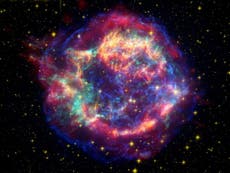Many more stars could be travelling through the Milky Way than we realised

Scientists have spotted a white dwarf star hurtling across our galaxy after a thermonuclear explosion.
The star shot itself out of orbit with its own explosion, and is now travelling through the Milky Way, according to researchers.
It could be one of many such supernovas currently speeding through our galaxy without us knowing, researchers say.
It also suggests that there may be other types of supernovae in other galaxies that astronomers have not yet seen.
When the white dwarf was originally spotted, researchers noticed that it seemed to have an unusual atmosphere, leading to further research to understand where it had come from.
Read more

Astronomers discover brightest supernova ever seen
Now astronomers at the University of Warwick have revealed that the star was probably once part of a binary star that exploded in a supernova, sending it and its partner flying out through the galaxy in different directions.
The star is travelling at 900,000 kilometres per hour, the researchers who spotted it say. It also appears to be particularly low in mass, which scientists say is probably the result of the supernova explosion.
Since researchers spotted the star known as SDSS J1240+6710 in 2015, they noted that unlike other white dwarfs – which tend to be almost entirely composed of hydrogen or helium – it was instead made up of a strange mix of oxygen, neon, magnesium and silicon. Further examination by the Hubble Space Telescope showed that it also had carbon, sodium, and aluminium in its atmosphere, which happen to be created in the early reactions that make up a supernova.
Now astronomers at the University of Warwick have revealed that the star was probably once part of a binary star that exploded in a supernova, sending it and its partner flying out through the galaxy in different directions.
The star is travelling at 900,000 kilometres per hour, the researchers who spotted it say. It also appears to be particularly low in mass, which scientists say is probably the result of the supernova explosion.
Since researchers spotted the star known as SDSS J1240+6710 in 2015, they noted that unlike other white dwarfs – which tend to be almost entirely composed of hydrogen or helium – it was instead made up of a strange mix of oxygen, neon, magnesium and silicon. Further examination by the Hubble Space Telescope showed that it also had carbon, sodium, and aluminium in its atmosphere, which happen to be created in the early reactions that make up a supernova.
It is also lacking some of the heavier elements that would normally be made up from the lighter ones during the key parts of the supernova explosion. Researchers suggest that indicates that the star only went through a partial supernova process, with the nuclear reaction dying out before it could finish.
"This star is unique because it has all the key features of a white dwarf but it has this very high velocity and unusual abundances that make no sense when combined with its low mass," said lead author Boris Gaensicke from the Department of Physics at the University of Warwick in a statement.
"It has a chemical composition which is the fingerprint of nuclear burning, a low mass and a very high velocity: all of these facts imply that it must have come from some kind of close binary system and it must have undergone thermonuclear ignition. It would have been a type of supernova, but of a kind that that we haven't seen before."
The supernova did however develop enough to disrupt the star's orbit with its partner in the binary system from which it came. That probably led to a very fast ejection of much of its mass, sending both stars off in different directions, and explaining the star's strange speed.
"If it was a tight binary and it underwent thermonuclear ignition, ejecting quite a lot of its mass, you have the conditions to produce a low mass white dwarf and have it fly away with its orbital velocity," said Professor Gaensicke.
No comments:
Post a Comment